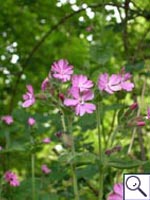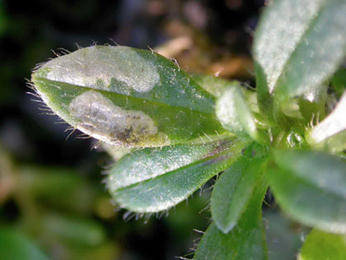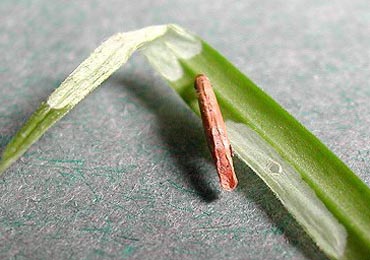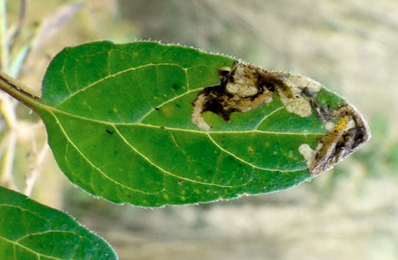 |
| |
(Coleoptera, Diptera, Hymenoptera and Lepidoptera)
by
Brian Pitkin, Willem Ellis, Colin Plant and Rob Edmunds
|
|
SILENE.
Campions and Catchflys. [Caryophyllaceae]
|
Forty-four
species of Silene are recorded in Britain. These include
the native Moss Campion (S. acaulis), Sand Catchfly (S.
conica), Red Campion (S. dioica), Small-flowered Catchfly
(S. gallica), White Campion (S. latifolia), Night-flowering
Catchfly (S. noctiflora), Nottingham Catchfly (S. nutans),
Spanish Catchfly (S. otites), Sea Campion (S. uniflora)
and Bladder Campion (S. vulgaris).
Lychnis chalcedonica is treated as Silene chalcedonica and Lychnis flos-cuculi is treated as Silene flos-cuculiby Stace
(2010).
Moss
Campion (S. acaulis) is protected in Northern Ireland under
Schedule 8 of the Wildlife (Northern Ireland) Order, 1985.
Fifteen British miners are recorded on Silene.
Elsewhere
the tephritid Philophylla
caesio is recorded as a miner in the petioles of Urtica sp. by Ferrar
(1987), Beiger (1968)
and White (1988), although
there are unconfirmed records on Caprifoliaceae and Asteraceae, which seems an odd combination of hosts.
The
agromyzid Ophiomyia
melandryi feeds in the stems of Silene in Britain
and elsewhere.
The
tortricid Cnephasia
conspersana is recorded as a seed / shoot-feeder on Silene in Britain.
A key to the European miners recorded on Silene is provided in Bladmineerders van Europa. |

Red Campion
Silene dioica |
Key for the identification of the known mines of British
Diptera recorded on Silene
|
Note: Diptera larvae may live in a corridor mine, a corridor-blotch mine, or a blotch mine, but never in a case, a rolled or folded leaf, a tentiform mine or sandwiched between two more or less circular leaf sections in later instars. Pupation never in a cocoon. All mining Diptera larvae are leg-less maggots without a head capsule (see examples). They never have thoracic or abdominal legs. They do not have chewing mouthparts, although they do have a characteristic cephalo-pharyngeal skeleton (see examples), usually visible internally through the body wall. The larvae lie on their sides within the mine and use their pick-like mouthparts to feed on plant tissue. In some corridor miners frass may lie in two rows on alternate sides of the mine. In order to vacate the mine the fully grown larva cuts an exit slit, which is usually semi-circular (see Liriomyza huidobrensis video). The pupa is formed within the hardened last larval skin or puparium and as a result sheaths enclosing head appendages, wings and legs are not visible externally (see examples).
See Key to non-Diptera.
|
1a > Stem-miner or Leaf and Stem-miner |
2 |
1b > Leaf-miner |
3 |
2a > Stem miner: A shallow external stem-mine (Spencer, 1972b: 29).
The
mine generally starts as a fine, lower-surface, corridor the seems
to end upon a thick vein. In reality the corridor continues by way
of the petiole to the stem, where a very long mine is formed in
the rind. Frass in widely spaced grains. Pupation within the mine,
mostly just above a node; the anterior spiracles penetrate the epidermis. |
On Lychnis, Moehringia and Silene in Britain and additional
genera and species of Caryophyllaceae elsewhere. Only known from
Hunts, Monmouth and Warwick in Britain. Widespread in continental
Europe.
|
Ophiomyia
melandricaulis Hering, 1943 [Diptera: Agromyzidae]. |
2b > Leaf and Stem-miner: Eggs
are scattered individually over the leaf upper surface; they are
only loosely attached to the plant. The egg shell has a honeycomb
structure. The larva begins with first mining one of the top leaves
completely out. Next the larva moves down to another leaf, by way
of a tunnel made in the stem. In this way several leaves are mined
out, completely and full depth. In the attacked part of the plant
the stem has become translucent; the damage causes the plant tip
to wilt. In the first mines almost no frass is to be found, further
down it is deposited in coarse grains. Pupation generally outside
the mine (Miles, 1953). |
|
On ? Agrostemma,
? Arenaria,
? Cerastium, ? Dianthus, ? Gypsophila,
? Lychnis,
? Saponaria, Silene,
? Spergularia,
? Stellaria, Vaccaria, Atriplex,
? Chenopodium, Spinacia and
? Phlox in
Britain. On Amaranthus, Agrostemma,
Arenaria, Cerastium, Dianthus, Gypsophila,
Lychnis, Saponaria, Silene, Spergularia, Stellaria, Vaccaria,
Atriplex, Chenopodium, Spinacia, Phlox and Primula elsewhere.
Recorded from Warwick and West Ross in Britain. Widespread in
continental Europe.
|
Delia echinata (Seguy, 1923) [Diptera: Anthomyiidae]. |
2c > Leaf and Stem-miner: Leaf and stem mine. Mine always arising from the leaf base or ending
in it, because the larva mines and changes leaves. Mine often broad,
irregular corridor like, often touching the midrib. At first corridor
often entirely without frass, later in the spring the mines are
often less deep, containing thick, irregularly deposited frass lumps. |
On ? Cheiranthus, Dianthus and ? Lychnis and ? Silene in Britain. Only recorded
in Warwick, Easterness and Surrey in Britain. Widespread in continental
Europe. Also recorded in the Near East and Nearctic Region.
|
Delia
cardui (Meigen, 1826) [Diptera: Anthomyiidae]. |
3a > Leaf-miner: A distinctive mine primarily above mid-rib, with irregular short
lateral offshoots into leaf blade. Pupation external (Spencer, 1972:
51 (fig. 172), 55; Spencer, 1976:
270, 271 (fig. 486)).
Branched,
whitish, upper-surface corridor; main axis overlying the midrib;
side branches overlying the main lateral veins. (In Campanula and Phyteuma the mine is much less branched, sometimes nothing
more than a corridor on top of the midrib). Frass in rather long
strings. Usually the mines begins as a long and narrow, shallow,
tortuous lower-surface corridor that ends upon the midrib but otherwise
is not associated with the leaf venation. Often this initial corridor
is filled with callus, and then even less conspicuous. Pupation
outside the mine.
A
linear mine on the upper surface, usually following the midrib and
showing side branches along the veins. The frass is in strings. |
|
Polyphagous. On more than 40 host genera in 15 families, but not yet on Silene, in Britain,. Widespread
throughout Britain. Also recorded in the Republic of Ireland.
Widespread in continental Europe.
|
Liriomyza strigata (Meigen, 1830) [Diptera: Agromyzidae]. |
3b > Leaf-miner: A
white linear-blotch mine, the linear section sometimes not detectable
as it becomes enveloped in later blotch (Spencer,
1976: 162-3, figs 296-7).
Upper-surface,
less often lower-surface, corridor, followed, and often overrun,
by a large blotch. Even when the corridor is overun, it usually
remains recognisable in the frass pattern. The mine looks whitish
in the field. The blotch does not contain much frass, in the form
of small black grains, dispersed and stuck to the floor of the mine.
Feeding punctures upper-surface (always?). Pupation outside the
mine.
A common miner, forming a white linear blotch mine (the blotch may obscure the linear portion of the mine) in both native and garden plants.The mine is also illustrated in the Encyclopedia of Life. |
|
On Agrostemma, Dianthus, Lychnis, Saponaria, Silene, Stellaria [Caryophyllaceae] and Atriplex, Beta and Spinacia [Chenopodiaceae] in Britain. Widespread in Britain and continental
Europe. Also Canada.
|
Amauromyza
flavifrons (Meigen, 1830) [Diptera: Agromyzidae]. |
3c > Leaf-miner: Upper
side blotch mine beginning with a deeper, almost full depth corridor.
Frass grains not in thread-like pieces, irregularly scattered. In
the large, later blotch indistinct primary and secondary frass lines
are found; the frass accumulated in the middle.
Each
mine begins with one, rarely two, oval egg shells attached to the
leaf underside. Sometimes a number of of young mines, and eggs,
on one leaf. The first part of the mine is a tortuous corridor,
quickly turning into a large blotch. Most of the blotch is full
depth, only some patches are upper-surface, and greenish in transparency.
According to the literature copious frass in present in dispersed
lumps. In my experience the larva -that then looks very dark- may
accumulate all frass in its body. The larva is capable of leaving
its mine, and starting a new one elsewhere. These secondary mines
can be recognised by the large hole that was made by the larva when
entering. Pupation outside the mine.
A gallery then a blotch, larger and deeper than Amauromyza flavifrons. In large leaves the mine is upper surface and all in one piece. In small leaves the whole leaf may be covered by a full depth mine with the larva mining several leaves in British
leafminers. |
|
|
On Cerastium, Lychnis, Myosoton, Silene and Stellaria in Britain and elsewhere. Widespread in Britain and continental
Europe.
|
Pegomya
flavifrons (Walker, 1849) [Diptera: Anthomyiidae]. |
3d > Leaf-miner: Blotch
mines, generally occupying an entire leaf, usually containing several
larvae. Much, half deliquescent, green frass. Mine indistinguishable from P.
exilis or P. hyoscyami. |
|
|
|
On Atriplex, Beta and ? Polygonum, but not yet on Silene, in Britain and additionally Silene and Spinacia [Caryophyllaceae], Chenopodium, Atropa, Hyoscyamus and Solanum [Solanaceae] in continental Europe. Only recorded from
Warwick in Britain. Also recorded in the Republic of Ireland,
Europe, the East Palaearctic and Nearctic Regions. Widespread in continental Europe including Balearic Is., Canary Is., Czech Republic, Danish
mainland, Finland, Greek mainland, Hungary, Italian mainland, Malta,
Norwegian mainland, Russia (Central), Sweden, East Palaearctic,
Near East, North Africa (Michelsen in Fauna
Europaea).
|
Pegomya
betae (Curtis, 1847) [Diptera: Anthomyiidae]. |
| 3e > Leaf-miner: Large
blotch mine, often with several larvae, beginning with a short deeper
corridor at a single egg shell on the surface of the leaf. The broad
deep corridor later ends in a blotch but can be recognised (beneath
the blotch) by its greater depth. Mine predominantly dorsal or ventral,
greenish in transmitted light. Frass grains irregularly scattered
except in the initial corridor.
Blotch,
mostly occupying almos the entire leaf, containing several larvae.
Much, half-deliquescent, greenish-black frass. At the start of the
mine at the leaf underside a group of some 5 elliptic egg shells,
parallel to each other. However, the larvae can leave their mine
and restart elsewhere, so mines without egg shells can occur as
well. The larvae do not penetrate into the stem of the plant, neither
is the mine full depth (compare Delia species). Mine indistinguishable from P.
exilis or P. hyoscyami.
Makes a large upper surface whitish blotch, which can contain several larvae. The frass has a washed out appearance and is greenish. There may be several mines on a leaf and eventually the leaf will be mined and then shrivel up. To identify this miner adults must be reared. |
|
|
On Silene [Caryophyllaceae], Atriplex, Beta, Chenopodium [Chenopodiaceae] and possibly Solanum [Solanaceae] in Britain and additional genera of Chenopodiaceae and Solanaceae
elsewhere. Known only from Inner Hebrides, Ayr and Warwick in
Britain. Also recorded in continental Europe and the East Palaearctic.
|
Pegomya hyoscyami (Panzer, 1809) [Diptera: Anthomyiidae]. |
3f > Leaf-miner: The
mine starts as a long, narrow, winding corridor running towards
the midrib, widening to a blotch. Usually upper-surface, but in
small leaves also full-depth parts may occur. The blotch has broad
lobes; in their ends most frass is accumulated in the form of green
patches or clouds. Sometimes several larvae share mine. Pupation
usually in the soil, less often in the leaf (and then generally
not in the mine itself but in a small separated mine, that may even
be made in the petiole). |

Mine of Scaptomyza graminum on Cerastium glomeratum
Image: © Jean-Yves Baugnée (Bladmineerders van Europa) |
|
Polyphagous. On
? Amaranthus, Cerastium, Lychnis, Myosoton, Nasturtium, Silene, Stellaria, Atriplex,
? Anthyllis, ? Lupinus,
? Medicago, ? Montia and ? Antirrhinum in Britain.
On Amaranthus, Lepidium, Moricandia, ? Rorippa, Agrostemma, Arenaria, Cerastium, Corrigiola, Cucubalus, Dianthus, Gypsophila, Lychnis, Moehringia, Myosoton, Polycarpon, Saponaria, Silene, Spergularia, Stellaria, Vaccaria, Viscaria, Atriplex, Beta, Chenopodium, Obione, Salicornia, Spinacia, Anthyllis, Lupinus, Medicago, Allium, Montia, Portulaca and Antirrhinum elsewhere. Widespread in Britain and continental Europe.
|
Scaptomyza
graminum (Fallén, 1823) [Diptera: Drosophilidae]. |
3g > Leaf-miner: Full depth, initially a much branched corridor, irregular
in width, in the end almost a blotch. The mine has openings by which
part of the frass is ejected. The larvae frequently leave the mine
to restart elsewhere. Older larva live free and cause window feeding,
often erasing their old mines. In Coltsfoot also pseudo-mines are
made, when the larva eats away the lower epidermis with the leaf
tissue, but spares the dense hair cover. |
On Ranunculus, but not yet on Silene, in Britain. On numerous genera and species in
several families elsewhere, including Adoxa. Distribution in Britain unknown. Widespread
in continental Europe.
|
Phytosciara
halterata Lengersdorf, 1926
[Diptera: Sciaridae]. |
|
|
Key for the identification of the known mines of British
non-Diptera recorded on
Silene
|
Note: The larvae of mining Coleoptera, Hymenoptera and Lepidoptera may live in a corridor mine, a corridor-blotch mine, a blotch mine, a case, a rolled or folded leaf, a tentiform mine or sandwiched between two more or less circular leaf sections in later instars. Larva may pupate in a silk cocoon. The larva may have six legs (although they may be reduced or absent), a head capsule and chewing mouthparts with opposable mandibles (see video of a gracillarid larva feeding). Larvae of Hymenoptera and Lepidoptera usually also have abdominal legs (see examples). Frass, if present, never in two rows. Unless feeding externally from within a case the larva usually vacates the mine by chewing an exit hole. Pupa with visible head appendages, wings and legs which lie in sheaths (see examples).
|
1a > Leaf-miner and case-bearer: The larva lives outside the mine, protected by a case, and feeds on the underlying plant tissues via a hole cut in the epidermis. From that point it eats away as much leaf tissue as it can reach without fully entering the mine. Mine does not contain frass (Coleophora species) |
2 |
1b > Leaf-miner, but not a case-bearer: The larva lives mainly inside the mine. Mine usually contains frass. In later instars the larva may live sandwiched between two more or less circular sections cut from the leaf. |
3 |
2a > Leaf-miner and case-bearer: The final case is about 12 mm long and many may be found on a single plant. The white case has distinctive longitudinal stripes. Trivalved tubular silken case of c. 12 mm long. Mouth angle c. 40°. The case is yellowish white, with several characteristic dark length lines. |

Case of Coleophora galbulipennella on Silene nutans
Image: © Jon Clifton (British leafminers) |
On Silene in Britain and Lychnis and Silene elsewhere. Apparently widespread in Britain including East Kent and Kirkudbright. Widespread in continental Europe.
|
Coleophora galbulipennella Zeller, 1838 [Lepidoptera: Coleophoridae]. |
2b > Leaf-miner and case-bearer: Larva mines leaves of Caryophyllaceae. The final case is tubular, 8 mm long, with a dorsal keel which forks and continues as two ridges to the anal end of the case. The larval case is very distinctive when fully grown as it is a pale pink colour and has a double dorsal keel. |

Case and mine of Coleophora lithargyrinella on Stellaria holostea
Image: © Rob Edmunds (British leafminers) |
On Arenaria, Cerastium, Silene and Stellaria in Britain and Arenaria, Cerastium and Stellaria elsewhere. Widespread in Britain and continental Europe. Also recorded in the Republic of Ireland.
|
Coleophora lithargyrinella Zeller, 1849 [Lepidoptera: Coleophoridae]. |
2c > Leaf-miner and case-bearer: Larva mines leaves, forming a case from an excised mine. This case is later extended, and widened by slitting the ventral side to insert a gusset. The full-grown case is 8 mm long with a single ventral keel. Full grown larva in a slender greyish white three-valved tubular silken case of c. 8 mm; mouth angle about 45°. Often several cases together on a small number of plants. |
|
|
On Cerastium, Myosoton, Silene and Stellaria in Britain and Arenaria, Cerastium, Myosoton and Stellaria elsewhere. The Isle of Wight in Britain. Widespread in continental Europe.
|
Coleophora solitariella Zeller, 1849 [Lepidoptera: Coleophoridae]. |
3a > Leaf-miner: In the first instar the larva mines the leaves, forming short,
irregular, blotch-like mines, but in later instars it lives externally,
feeding in spun leaves and often twisting those of tender shoots. Larval head light-brown or yellowish brown, edged with black postero-laterally,
ocellar area blackish; prothoracic plate black edged with whitish
anteriorly; abdomen dull dark green; pinacula distinct, black,
sometimes brownish but with black bases to setae; anal plate large,
black (Bradley et al., 1973).
Small,
full depth mine without a definite shape; little frass. Some silk
is deposited in the mine. The larva soon leaves the mine and continues
feeding among spun leaves. |
Polyphagous. On numerous genera and species of several plant families, but not yet on Silene, in Britain. On numerous genera and species of several plant families, including Silene, elsewhere. Widespread in Britain and continental Europe. Also recorded from the Channel Is.
|
Cnephasia incertana (Treitschke, 1835) [Lepidoptera: Tortricidae]. |
3b > Leaf-miner: Rather narrow corridor, untidy and sometimes branched, starting
from the base of the leaf, in particular the midrib. Sides of the
corridor irregularly eaten out, not really parallel. Frass mostly
present, and then in a central line. The larva is capable of leaving the mine and start a new one elsewhere. These later mines are much broader, and the frass is scattered irregularly.. |

Mine of Orthochaetes
insignis on Prunella vulgaris
Image: © Jean-Yves Baugnée (Bladmineerders van Europa) |
Host
plants unknown in Britain. On numerous genera and species in several plant families, including Carduus, elsewhere.
Recorded in southern England. Widespread in continental Europe.
|
Orthochaetes
insignis (Aube, 1863) [Coleoptera:
Curculionidae]. |
3c > Leaf-miner: In Belgium the larva lives in a silken tube in the sand and feeds
on the leaves of Cerastium fontanum touching the ground.
Pupation in a cocoon in the sand (Belgian
Lepidoptera).
On Cerastium in Britain and Cerastium and Silene elsewhere. Widespread in Britain,
Ireland and continental Europe.
|
Caryocolum
marmorea (Haworth, 1828) [Lepidoptera: Gelechiidae]. |
|
|
|
|